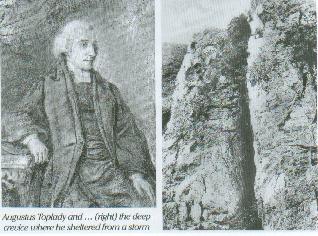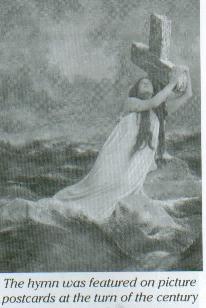ROCK OF AGES
|
Rock of Ages, cleft for me, Let me hide myself in thee; Let the water and the blood, From thy riven side which flowed, Be of sin the double cure, Cleanse me from its guilt and pow’r. |
Nothing in my hand I bring, Simply to thy Cross I cling; Naked, come to thee for dress; Helpless, look to thee for grace; Foul, I to the fountain fly; Wash me, Saviour, or I die. |
|
Not the labour of my hands Can fulfil thy law’s demands; Could my zeal no respite know, Could my tears for ever flow, All for sin could not atone; Thou must save, and thou alone. |
While I draw this fleeting breath, When my eyelids close in death, When I soar through tracts unknown, See thee on thy judgement throne; Rock of Ages, cleft for me, Let me hide myself in thee. |
AUGUSTUS TOPLADY – he wrote one of the world’s best hymns while sheltering from a violent thunderstorm.
LIGHTNING briefly illuminated the primitive, rock- hewn landscape of Burrington Combe in Somerset. It was followed by a deep growl of thunder, and then rain lashed mercilessly down, pouring bubbling streamlets down the craggy sides of primeval cliffs which rise up some 250ft. to the Mendip Heights on one side, and into Cheddar Gorge on the other.
The curate of Blagdon, a nearby village, had been travelling along the road near the cliffs when the storm struck and dashed into a cave for shelter. He had been fortunate to find this hiding-place so quickly, and while waiting for the storm to pass he began to muse on the idea of the “rock of faith” being a shelter from the “storms of life”. The words for a hymn began to form in his mind but, according to the legend that still persists, he had no paper in his pocket to write down the words. Looking down he saw a playing card, considered a sinful thing by the young cleric. Nevertheless, he picked it up and began to write:
Rock of ages, cleft for me,
Let me hide myself in thee.
The curate was Augustus Montague Toplady, and such is the popular story behind the origin of one of the world’s best-loved hymns which was first published in the Gospel Magazine in 1775, some 12 years after Toplady wrote it.
Augustus was born at Farnham, Surrey, on 4th November 1740, and violent thunderstorm probably was never seen by his father, Richard Toplady, a major in the army who was killed in the Siege of Carthagena soon after his son was born. So Augustus was left in the care of his mother, Catherine, daughter of Dr. Bate of Canterbury, who indulged him. However, his Uncle Julius, Rector of St. Paul’s, Deptford, was a stem disciplinarian. It is recorded that the boy kept a delightful diary describing his mother’s fondness, his uncle’s cross speeches, and including boyish prayers and sermons. He was educated at Westminster School, London, and Trinity College, Dublin, and it was while in Ireland he was converted by a sermon from James Morris, a follower of John Wesley. This took place one August evening in about 1755 in a barn in Codymain. But soon afterwards, Toplady rejected Wesley’s “methodism” in favour of the more extreme views of Calvinism and a bitter enmity developed between the two men.
 Toplady was ordained deacon by the Bishop of Bath and Wells on 5th June 1762, after which he became curate at Blagdon. His famous hymn, written at this time, is commemorated by a window still to be seen in the village church. Following his ordination as a priest in 1764, he took the curacy at Farleigh Hungerford in Somerset. In 1766 he moved to Devon to become vicar of St Gregory’s, Harpford but it is thought that he obtained this living by purchase, or some means which afterwards bothered his conscience. A memorial cross in the churchyard, put there in 1913, stands on the ruined shaft of a much older cross that was there long before Toplady’s time. Lines from the third verse of Rock of Ages have been inscribed on the base of the cross.
Toplady was ordained deacon by the Bishop of Bath and Wells on 5th June 1762, after which he became curate at Blagdon. His famous hymn, written at this time, is commemorated by a window still to be seen in the village church. Following his ordination as a priest in 1764, he took the curacy at Farleigh Hungerford in Somerset. In 1766 he moved to Devon to become vicar of St Gregory’s, Harpford but it is thought that he obtained this living by purchase, or some means which afterwards bothered his conscience. A memorial cross in the churchyard, put there in 1913, stands on the ruined shaft of a much older cross that was there long before Toplady’s time. Lines from the third verse of Rock of Ages have been inscribed on the base of the cross.
Toplady was at Harpford for two years before moving to nearby Broadhembury to become vicar of St. Andrew’s. He held the living there for 10 years until his death in 1778 at the age of 38.
Toplady was author of a number of learned works on church doctrine. He also wrote poems and psalms, and apart from Rock of Ages his 132 other hymns include A Debtor to Mercy Alone, A Sovereign Protector I Have and From Whence This Fear and Unbelief.
His bitter arguments with Wesley date from 1769, following the latter’s contemptuous remarks about Toplady’s translation of a Latin treatise on Calvinism. It brought to a head their different opinions about whether or not people are predestined for salvation. An abridgement of the translation was published by Wesley for the use of the Methodist societies and there followed a number of angry exchanges between the two men which became more personally abusive, especially in the case of Toplady. But such unpleasantness was far from typical of the man. He could write charming essays, and was charitable. His main fault seemed to be youthful conceit and we must remember that he was only 29 years old at the start of this controversy.
Wesley later declined to be further involved in the argument and it was left to Walter Sellon, another prominent Methodist, to continue the controversy. Wesley told a friend that he would not fight with “chimney-sweepers”, as he called Toplady. “I leave him to Mr Sellon. He cannot be in better hands!”
Toplady was editor of the Gospel Magazine from December 1775 to June 1776 and continued his harassment of Wesley and his followers in the pages of the magazine, but signs of consumption in 1776 resulted in his removal from Broadhembury to London, where he ministered in the French Calvinist Reformed Church in Orange Street for the remaining two years of his life. But there was never a reconciliation with Wesley. When Toplady was in the final stages of consumption, a story reached him in which he was reported to have altered his views and wished to see Wesley. Rising from his sick-bed he was carried into the pulpit at Orange Street and delivered a sermon denying any change in his beliefs and affirming his opposition to Wesley. He died on 14th August 1778 and was buried in Tottenham Court Chapel. A marble tablet was erected to his memory.
Afterwards, a malicious story circulated that Toplady had died in black despair, uttering terrible blasphemies. An appeal was made to Wesley by Sir Richard Hill against this unfounded allegation. It was supported by a petition signed by 13 witnesses of the Calvinist minister’s last hours.
The plaque in Broadhembury church mentions his “personal piety, brilliant gifts, sanctified learning, and uncompromising advocacy of the gospel of the Sovereign Grace of God”. But his fame rests mainly on the hymn he wrote as a humble curate at Blagdon. And what finer memorial could anyone have than Rock of Ages.
PETER BAYLISS
We thank the proprietors of This England Magazine for permission to reproduce this article from the Winter 1988 Issue


